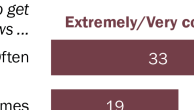Aside from weather, more Americans get news about local crime than any other local news topic we asked about in our survey.
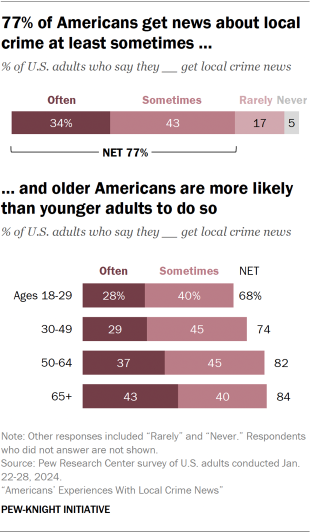
Roughly three-quarters of U.S. adults (77%) say they often or sometimes get news and information about local crime, including 34% who say they often do. Far fewer report rarely (17%) or never (5%) getting news about local crime.
Although majorities of adults in all age groups get local crime news at least sometimes, older Americans are more likely to say they do this than younger people.
This pattern by age aligns with broader local news consumption habits. For instance, older Americans are more inclined to closely follow local news in general and to get news about all of the local news topics we asked about.
Black Americans also stand out for higher rates of crime news consumption: 45% of Black Americans report getting news about local crime often, compared with smaller shares of Hispanic (34%), White (32%) and Asian (30%) adults. Black Americans also are more likely than other racial and ethnic groups to follow local news in general very closely.
Americans who get news about local crime more often are more concerned about crime affecting them or their family:
- Among those who say they often get news about local crime, 65% say they are at least somewhat concerned about crime in their community affecting them personally, including 33% who are extremely or very concerned.
- By comparison, among those who rarely or never consume local crime news, about four-in-ten (39%) are at least somewhat concerned about crime affecting them or their family (10% are extremely or very concerned).
The survey cannot confirm which is more likely: that news about local crime leads people to become more concerned, or that people who are already concerned about local crime consume more news about it.
Where Americans get news about local crime
Americans report getting news and information about local crime from a variety of sources:
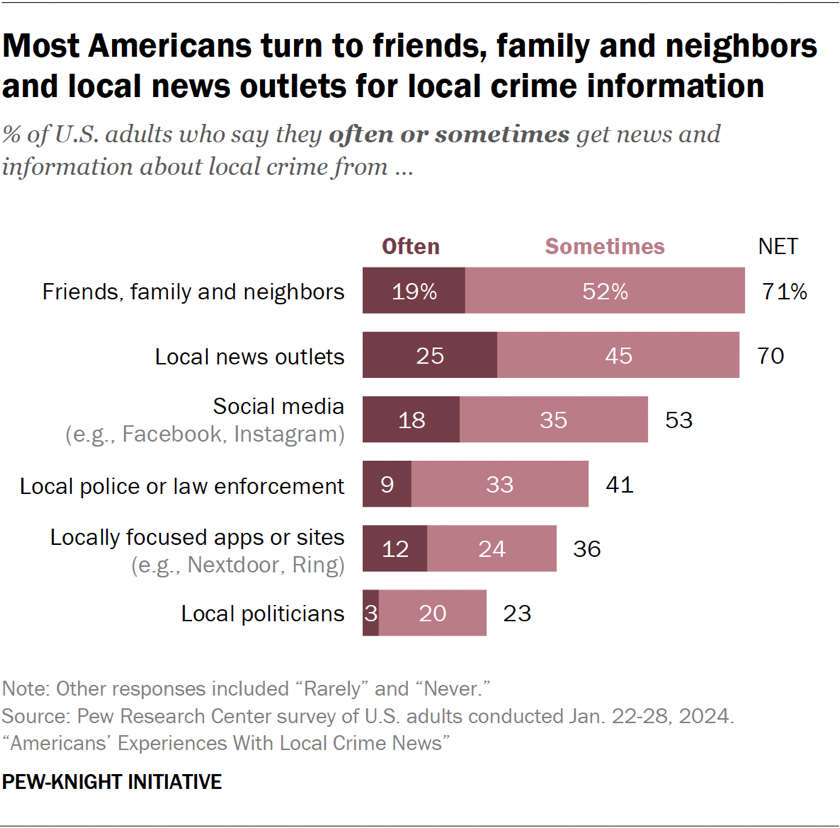
- About seven-in-ten (71%) say they often or sometimes get local crime news from friends, family and neighbors. A similar share (70%) at least sometimes get local crime news from local news outlets.
- About half of U.S. adults get local crime news from social media (53%).
- Fewer turn to local police or law enforcement (41%), locally focused apps or sites (36%) or local politicians (23%) for this information.
We find little difference in where people get crime information by political party. Republicans and Democrats (including independents who lean toward each party) get crime news from most types of sources mentioned in the survey at similar rates. For example, 72% of Republicans and 69% of Democrats at least sometimes get crime news from local news outlets. Republicans are slightly more likely than Democrats to turn to friends, family and neighbors (75% vs. 69%) and local law enforcement (44% vs. 39%) for crime news.
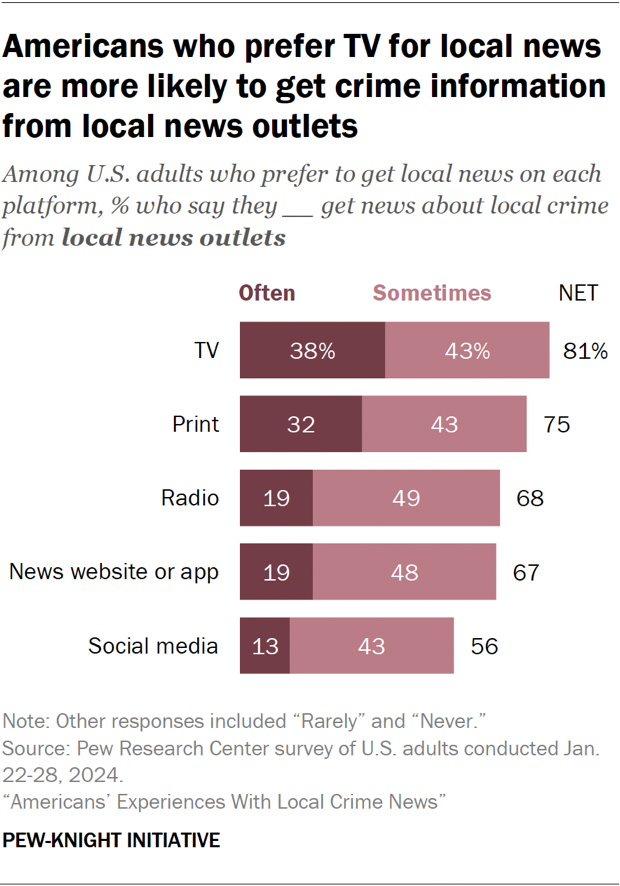
Our survey did not explore how each of these sources are accessed – for instance, if people get crime information from local news outlets via print, TV or online. However, Americans who prefer television for getting local news in general are more likely than those who prefer all other pathways (such as websites or social media) to say they get crime information from local news outlets.
For instance, 81% of U.S. adults who prefer to get local news from TV say they often or sometimes get crime news from local outlets, compared with 67% of those who prefer to get local news from news websites or apps.
Local crime news sources by age
Younger Americans are more likely than older adults to get information about local crime from social media, while older Americans are more likely to get it from news outlets. This matches the pattern seen for news about local government and politics.
Differences across age groups include:
- Adults under 30 are roughly twice as likely as those ages 65 and older to say they often or sometimes get local crime news from social media (69% vs. 34%).
- Just over three-quarters of adults 65 and older (78%) and 50 to 64 (77%) say they at least sometimes get crime information from local news outlets, compared with smaller majorities of those ages 30 to 49 (65%) and 18 to 29 (58%).
- Adults 65 and older are the most likely age group to get crime news from local politicians (29%, vs. 19% of those 18 to 29).
Younger Americans are just as likely as older ones to get information about local crime from their personal networks. Americans also turn to local police or law enforcement for crime information at similar rates across age groups.
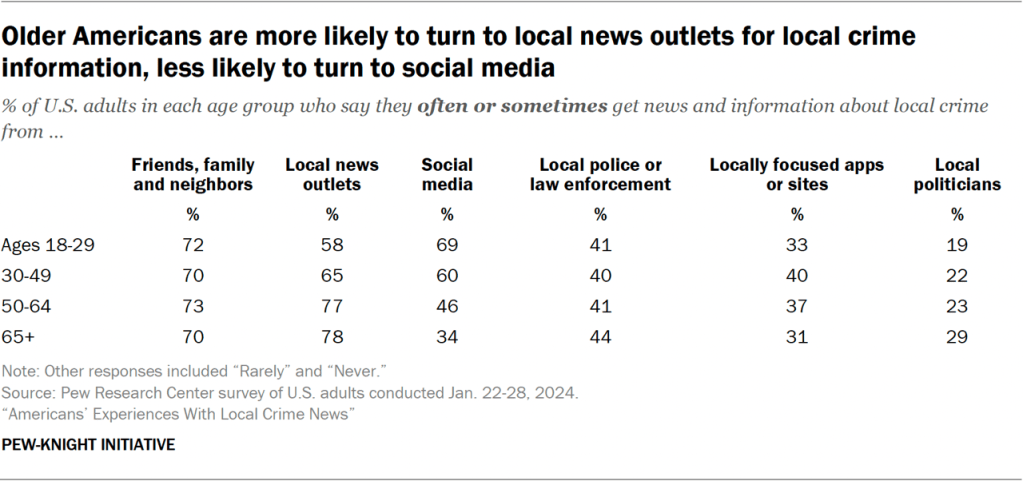
Where Americans go first for information about a local crime
While many people get news and information about local crime from multiple sources, the survey also asked respondents where they would go first to learn more about a crime in their community. No single source dominates: Americans turn to several different sources as their first choice for news about a local crime.
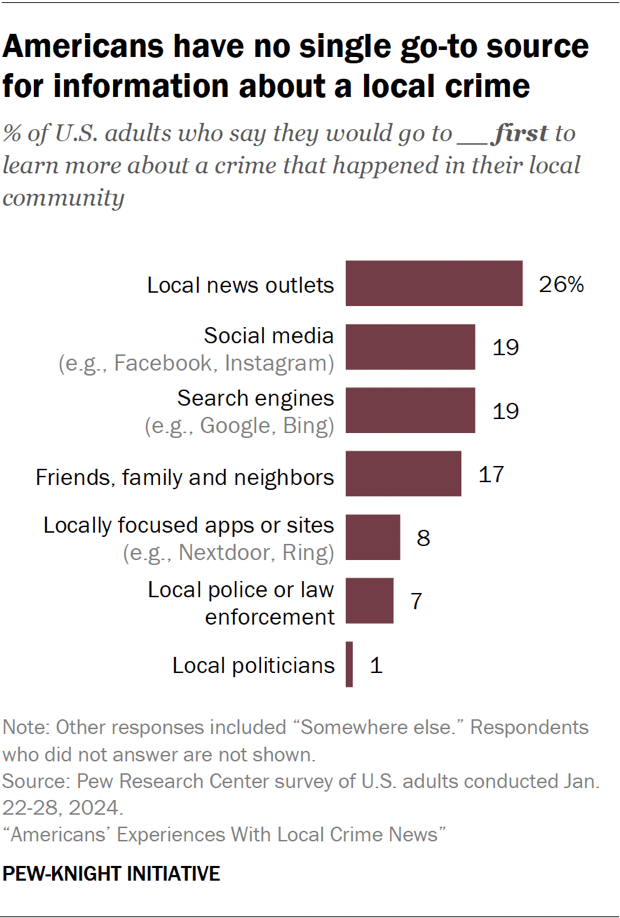
About a quarter of Americans (26%) say they would first go to local news outlets to learn more about a crime in their local community. But many others look explicitly to digital sources, including social media (19%), search engines (19%), and locally focused apps or sites such as Nextdoor or Ring (8%).
Meanwhile, 17% would first ask friends, family and neighbors about what happened, and 7% would turn to local police or law enforcement. Just 1% of Americans say they would look first to local politicians for information about a crime in their community.
The type of community Americans live in plays a role in which sources they use first for information about a crime. For instance, Americans who live in rural areas (26%) are more likely than those living in suburban (15%) or urban (13%) areas to turn to friends, family and neighbors first for more information about a crime in their community.
